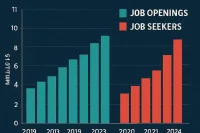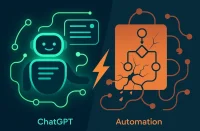OpenAI’s game plan — becoming the iPhone of AI
OpenAI’s game plan is crystal clear: become the iPhone of AI. While this comparison gets thrown around loosely, it holds real weight for OpenAI because they’ve built more than just ChatGPT—they’ve created a comprehensive developer platform on top of their foundation models. The company sits at the convergence of government demand, consumer demand, and enterprise demand, making them the bellwether for how to monetize AI in 2025.
The three-pillar strategy
Developer platform dominance
OpenAI’s developer platform extends far beyond consumer-facing ChatGPT. They’ve created an ecosystem where developers can build applications on top of their foundation models, similar to how Apple’s App Store revolutionized mobile computing. This platform approach creates network effects and lock-in that traditional AI companies struggle to match.
Multi-market convergence
Unlike competitors focused on single markets, OpenAI operates across three massive demand vectors simultaneously. Government contracts provide stable, long-term revenue. Consumer adoption drives brand recognition and data collection. Enterprise partnerships offer high-margin, scalable opportunities.
Foundation model leadership
Their foundation models serve as the underlying infrastructure for the entire AI ecosystem. By maintaining technological leadership in large language models, OpenAI ensures their platform remains the go-to choice for developers and enterprises worldwide.
Capital expenditure as the linchpin
Why CapEx matters most
For investors, nothing matters more than capital expenditure trends. OpenAI’s game plan depends entirely on continued massive CapEx investments from tech giants. The good news: year-over-year CapEx growth projections for 2025 show continued expansion, suggesting the AI investment cycle remains intact.
Infrastructure requirements
AI development requires unprecedented computing power. Every major tech company is increasing GPU deployments for AI systems from 8 to 72 units—a 9x increase. This creates a tsunami of demand for AI networking infrastructure, with projected growth of 5x to 9x in the coming years.
Partnership strategy and market positioning
Strategic alliances
OpenAI’s recent partnership announcements aren’t just PR moves—they’re strategic positioning for market dominance. The company has secured deals across multiple sectors, creating a web of dependencies that strengthen their competitive moat.
Customer and repurchase agreements
Solid blue lines in their partnership map represent customer and repurchase agreements—the most valuable type of partnership. These provide predictable revenue streams and demonstrate real market demand for OpenAI’s technology.
Investor relationships
Dotted lines show investor relationships that provide both capital and strategic advantages. These connections help OpenAI access new markets and technologies while maintaining their independence.
AI networking infrastructure boom
The tsunami effect
AI networking represents a massive market opportunity as companies scale their AI infrastructure. The 9x increase in GPU requirements creates unprecedented demand for networking solutions that can handle the data transfer requirements of modern AI systems.
Astera Labs opportunity
Companies like Astera Labs benefit from this infrastructure boom. As a small player in a massive market, they only need a few major customers to drive significant growth. With Amazon spending over $100 billion annually on AI infrastructure, even small partnerships can have outsized impact.
Energy infrastructure implications
Bloom Energy’s advantage
The AI boom is driving unprecedented demand for data center power. Bloom Energy’s hydrogen fuel cells can be deployed in just three months compared to years for nuclear power plants. This speed advantage makes them essential for rapid AI infrastructure expansion.
Off-grid power solutions
Bloom Energy’s ability to provide power not tied to the traditional grid is crucial for AI data centers, which often require massive amounts of electricity in locations where grid capacity is limited.
Chip market dynamics
Blackwell and Blackwell Ultra
The AI chip market is entering a critical phase with Blackwell and Blackwell Ultra chips shipping simultaneously. This represents a major inflection point in the AI hardware cycle, with significant implications for the entire ecosystem.
Consolidation opportunities
While some consolidation in the chip market may be overdue, any pullbacks should be viewed as buying opportunities. The fundamental demand drivers for AI chips remain strong, supported by continued CapEx growth and infrastructure expansion.
Build the Future of AI Hardware
With Blackwell and Blackwell Ultra chips defining a new era in AI hardware, the demand for top talent in semiconductors has never been higher. Employers can get ahead of the cycle by hiring engineers, designers, and specialists driving the next wave of chip innovation. Post your job on WhatJobs today and connect with professionals ready to shape the future of AI infrastructure.
Post a Job Free for 30 Days →Investment implications
OpenAI’s competitive moat
OpenAI’s game plan creates multiple competitive advantages: platform effects, multi-market presence, and technological leadership. This combination makes them extremely difficult to displace, even as new competitors enter the market.
Ecosystem beneficiaries
Companies that provide infrastructure for OpenAI’s ecosystem—from networking equipment to power solutions—stand to benefit significantly from their continued growth and expansion.
FAQs
Q: What is OpenAI’s game plan for market dominance?
A: Become the iPhone of AI by building a developer platform, serving government/consumer/enterprise markets, and maintaining foundation model leadership.
Q: Why is CapEx crucial to OpenAI’s game plan?
A: AI development requires massive computing power, and continued CapEx growth from tech giants is essential for OpenAI’s expansion and market position.
Q: How does OpenAI’s game plan benefit infrastructure companies?
A: OpenAI’s growth drives demand for AI networking, power solutions, and chip infrastructure, creating opportunities for companies like Astera Labs and Bloom Energy.
Q: What makes OpenAI’s game plan different from competitors?
A: Their three-pillar strategy (platform, multi-market presence, foundation models) creates network effects and competitive moats that single-market competitors can’t match.
Live example — user point of view
As an AI infrastructure investor, I’ve been tracking OpenAI’s partnerships as leading indicators of market direction. Their game plan of becoming the iPhone of AI isn’t just marketing—it’s a strategic framework that’s already working. The convergence of government, consumer, and enterprise demand creates a moat that’s nearly impossible to replicate, making OpenAI the safest bet in the AI space.




